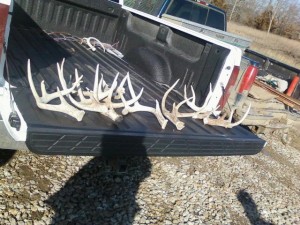Pt. 5: Top 10 Recommendations for Managing Land to Yield Mature, Huntable Deer
Filed under: Deer Hunting, Deer Management, Hunting Blog
Part 5: Bottlenecks
Yesterday I toured a property in central Missouri with the mission of helping the landowner produce more mature bucks and increase his and his guests’ odds of harvesting them. My comments to the landowner were directly in line with the past four blog entries in this series. We talked about the age structure of the herd on his property, planned several additional feeding and hunting food plots to improve the quantity of quality forage available to the herd, and reviewed the existing cover.
While touring this property four of us found about 20 sheds!

Shed antlers found on the property
Some of these sheds, including the larger ones, were found in bottlenecks.What are bottlenecks? They are physical barriers that limit deer movement to a known and relatively small area. You might call these features pinch points, funnels, etc. Where I was working yesterday, there were several strip pits and dump piles. Strip pits (at least at this property) are about 30’ deep by 150’ wide trenches where coal was mined decades ago. These are now filled with water and are fishing lakes. The dirt from these pits was typically “dumped” close by after the coal was removed.
The dumps are steep, rough, and tough to transverse for man or beast. Deer will certainly go in the dumps and frequently use them as cover, etc., but prefer not to travel through dumps when moving from point A to point B. There were several places where the dumps were within 40-50 yards from the end of a strip pit that was several hundred yards long. The flat ground in between the dumps and the pits created great bottlenecks!
Typically, the longer the barrier (dumps or strip pits on this property) the more utilized the bottleneck. The trails, rubs, etc., we found near the bottlenecks on this property were enough to excite any hunter! I was so excited about the amount of buck sign in these bottlenecks I was ready to begin hanging stands!
My property is just the opposite. It is large patches of hardwoods with a few food plots mixed in. It is very tough to pattern where bucks will travel on my property with any certainty. This is called homogenous habitat. Crop land in the Midwest is full of bottlenecks. Wide open crop fields, especially after the crops have been harvested, tend to funnel buck movement into narrow wood lots, or CRP fields. Where the whitetails move is much more predictable in those areas compared to land that is basically one habitat type (like all woods).
However, bottlenecks can be created! Depending on where I’m working and what’s available, I’ve used discarded round bales of hay, snow fence, etc. Sometimes low value trees can be felled to make bottlenecks. I don’t like this approach as well as others because trees tend to decay rapidly and it’s tough to fell trees in a line with no gaps.
If you are like me and primarily hunt areas where there are very few natural bottlenecks, consider using a readily available resource and creating some. Consider how to approach the stand, wind direction, etc. It’s often easier to grow mature bucks than it is to harvest mature bucks. Creating a bottleneck is an outstanding tool to reap the benefits of your deer management efforts.
Growing (and killing) Deer together,
Grant



